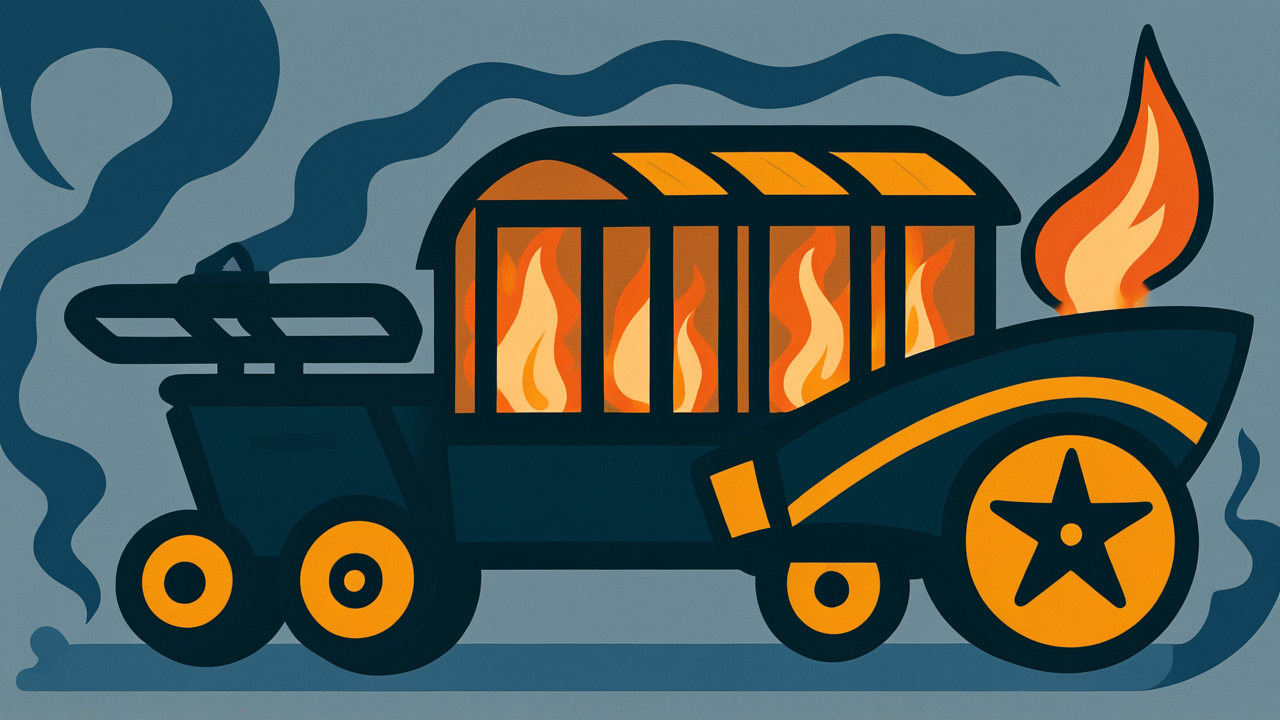How to Read “火の車”
Hi no kuruma
Meaning of “火の車”
“Fire’s vehicle” is a proverb that expresses being in an extremely difficult situation or dire circumstances.
It particularly often refers to a state of economic hardship, meaning being in financial trouble and unable to make ends meet, but it’s not limited to that—it expresses all kinds of situations where one is cornered mentally and physically. It expresses real-life painful situations by comparing them to the intense suffering of being burned in hell’s fire’s vehicle.
This proverb doesn’t simply mean being in light trouble, but represents a state where one is experiencing hell-like suffering so serious that escape is no longer possible. It’s used when household finances are on the verge of collapse, when one is chased by debt and unable to move, or when experiencing extreme stress from work or relationships. Even today, it’s understood by many people as a powerful proverb that expresses urgency and seriousness.
Origin and Etymology
The origin of “Fire’s vehicle” lies in the terrifying instruments of punishment depicted in Buddhist hell paintings. In Buddhism, it was believed that those who committed evil deeds in life would fall to hell and be made to ride a blazing fire’s vehicle to suffer. This fire’s vehicle had wheels and body all engulfed in flames, and sinners would be burned eternally upon it—truly a symbol of unimaginable suffering.
From the Heian to Kamakura periods, many picture scrolls and temple murals depicting the horrors of hell were created, and among these, the fire’s vehicle was particularly impressive and carved into people’s memories. Eventually, this image of hell’s fire’s vehicle came to be used as an expression for intense suffering and difficult situations in the present world.
By the Edo period, it was already widely used in its current meaning and had become established as an expression particularly referring to economic hardship. The suffering of being burned by hell’s karmic fire was overlaid with the feelings of people troubled by life’s hardships, and “Fire’s vehicle” became a proverb deeply rooted in the Japanese heart.
Usage Examples
- Being chased by monthly payments, I’m already in a fire’s vehicle state
- Days of fire’s vehicle continue with balancing childcare and work
Modern Interpretation
In modern society, “Fire’s vehicle” is used as an expression for more diverse predicaments, going beyond the traditional meaning of economic hardship. Particularly in the information society, it has come to be frequently heard not only for economic problems but also in situations expressing temporal urgency and mental burden.
While work style reform is being advocated, for modern people who are actually chased by long working hours and excessive duties, “Fire’s vehicle” has become a familiar expression. Among child-rearing generations, it’s “Fire’s vehicle” balancing work and childcare; for students, it’s “Fire’s vehicle” with job hunting and exam studying; for the elderly, it’s “Fire’s vehicle” with nursing care and medical expenses—it’s a highly versatile proverb used regardless of generation.
With the spread of SNS and the internet, individual predicaments have become more visible in modern times, and many people show empathy for the expression “Fire’s vehicle,” functioning rather as a word that creates solidarity. Also, on TV and internet news, it’s frequently used when expressing corporate management difficulties or local government fiscal crises, and is valued as an effective expression that conveys the seriousness to viewers in an easy-to-understand way.
However, in modern times, many people don’t know the original religious background of hell’s karmic fire, and it’s sometimes used in the light meaning of simply being “busy” or “tough.”
When AI Hears This
The linguistic evolution of “hi no kuruma” (fire cart) represents a fascinating phenomenon where Japanese religious sensibilities and pragmatism merged beautifully.
In Buddhist scriptures, the “fire cart” was depicted as a flaming chariot used by hell’s jailers to transport sinners, but during the Edo period’s commercial society, it transformed into everyday language expressing “economic hardship.” This shift reflects changes in common people’s religious consciousness at the time. From the mid-Edo period onward, Buddhism became increasingly formalized through the temple registration system, and interest shifted from fear of hell toward worldly benefits.
What’s particularly noteworthy is that when merchants and craftsmen expressed debt or business difficulties, they didn’t simply use words like “poverty” or “hardship,” but deliberately borrowed imagery from hell. This shows they perceived economic struggles as serious problems truly comparable to the suffering of hell itself.
Even more intriguing is how what was once an object of terror—a supernatural entity—actually settled into common usage as a familiar, approachable expression. The way people say “we’re also riding the fire cart” carries both gravity and a kind of lightness resembling resignation. This reflects a distinctly Japanese cultural tendency to “express heavy things lightly,” demonstrating the linguistic creativity that digests religious metaphors into practical wisdom for daily life.
Lessons for Today
What the proverb “Fire’s vehicle” teaches us modern people is that predicaments are part of life, and the importance of having the courage to accept them. Everyone experiences “Fire’s vehicle” somewhere in life, but that’s never something to be ashamed of.
Rather, what’s important is having the courage to seek help from those around us instead of bearing it alone, especially when in such situations. In modern society, we tend to dismiss difficulties as individual responsibility, but the fact that there’s a common expression like “Fire’s vehicle” is also proof that many people have similar experiences.
Also, this proverb gives us an opportunity to reconsider our priorities. We can reframe “Fire’s vehicle” situations as opportunities to think about what’s truly important and what we can let go of.
And above all, no matter how intense the flames, they don’t burn forever. “Fire’s vehicle” situations will surely change too. The strength to believe in that time and move forward step by step may be the true message this proverb wants to convey to us.



Comments